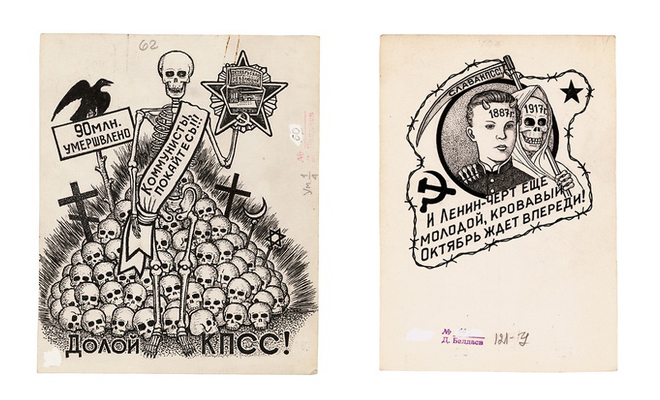Between 1948 and 1986, during his career as a prison guard, Danzig Baldaev made over 3,000 drawings of tattoos. They were his gateway into a secret world in which he acted as ethnographer, recording the rituals of a closed society. The icons and tribal languages he documented are artful, distasteful, sexually explicit and provocative, reflecting as they do the lives, status and traditions of the convicts that wore them. Baldaev made comprehensive notes about each tattoo, which he then carefully reproduced in his tiny St. Petersburg flat. The resulting exquisitely detailed ink drawings are accompanied with his handwritten notes and signature on the reverse, the paper is yellowed with age, and carries Baldaev’s stamp, giving the drawings a visceral temporality – almost like skin.
Via Fuel
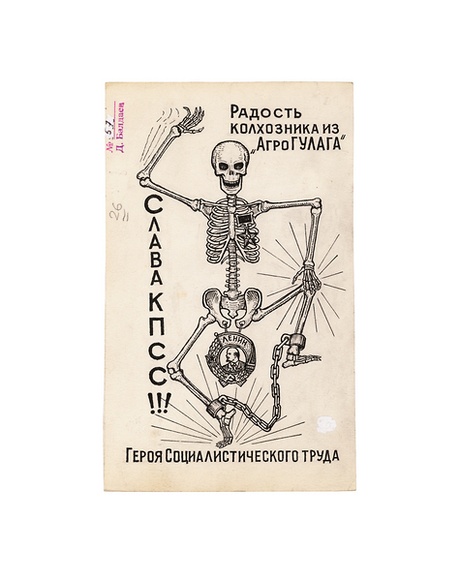
Text on the left reads ‘Glory to the Communist Party!!!’. Text at the top and bottom reads ‘The joy of a farmer from AgroGulag, the Honourable Worker of Socialist Labour’. Text on the award reads ‘Lenin’.
Corrective Labour Camp No.9. 1981. Hip.
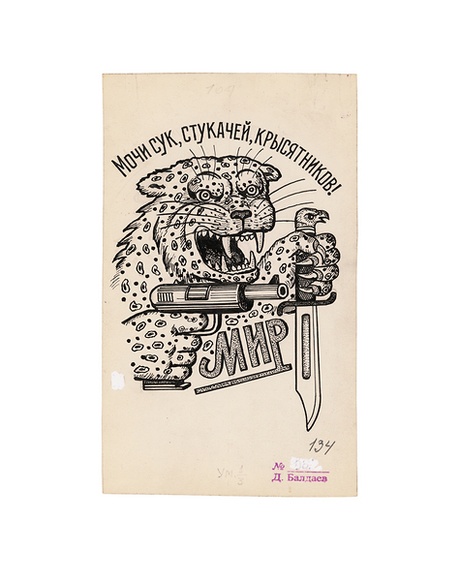
‘Take out bitches, stool-pigeons and traitors!’ The acronym ‘MIR’ spells the word for peace and stands for ‘Only shooting will reform me’.
A ‘warrior’s grin’.
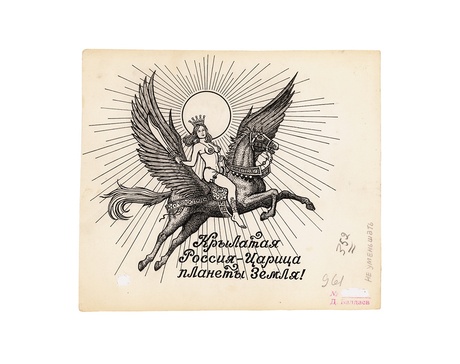
‘Winged Russia is the queen of planet Earth!’
Isolation Cell Block, 7 Arsenal Embankment, St. Petersburg.
A finely drawn tattoo made in a Moscow tattoo salon in 1994.
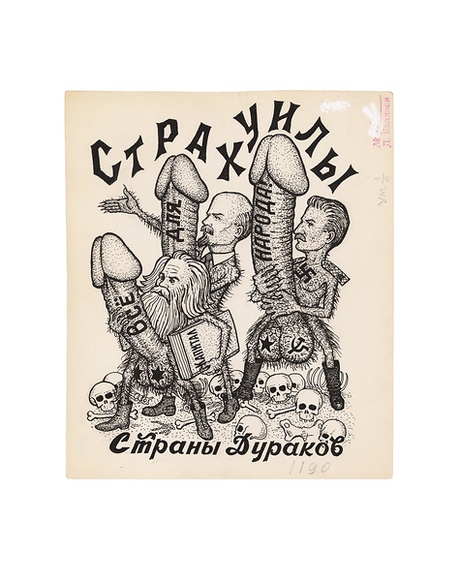
Text on top and bottom reads ‘The Scary Dicks of the Land of Fools’.
Text on penises reads ‘Everything for the people!’. The book is ‘Capital’
by Karl Marx.
Corrective Prison Camp No.9. 1989.
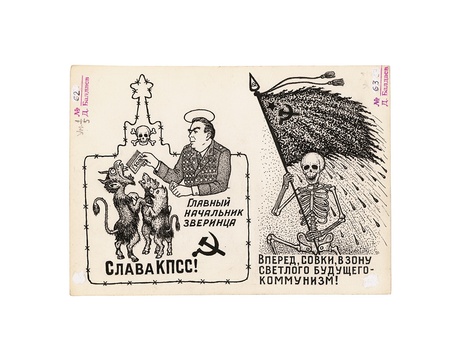
Left: Voronezhskie Baths, Ligovsky Prospekt, Leningrad. 1978.
An artistic ‘baring teeth at the authorities’ tattoo called ‘The Big Boss of the Zoo’. Common in the 1970s and 1980s.
Right: ‘Forward, Soviet jerks, into the Zone of the bright future of Communism!’
MVD Interregional Hospital, 1 Khokhryakov Street, Leningrad. 1971. Right hip.

Various thieves tattoos.
Top left: ‘Death to Garbage!’
Top centre: An anti-Semitic tattoo worn by a woman convicted for stealing food from a depot. She had cohabited with a Jew who was the head of the food depot where she worked. When she had a child by him, the Jew stopped seeing her and took up with a different lover – a young Russian girl.
Top right: ‘I am a slave of the MVD. US 20/5’
Middle centre: A tattoo known as ‘This is what is destroying us’.
Bottom left: A widespread thieves’ tattoo called ‘The Cheap Whore’.
Bottom right: This image of the Devil and a woman can either mean that a woman pushed the bearer to commit a crime, or that both the Devil and woman are hatched from the same egg.
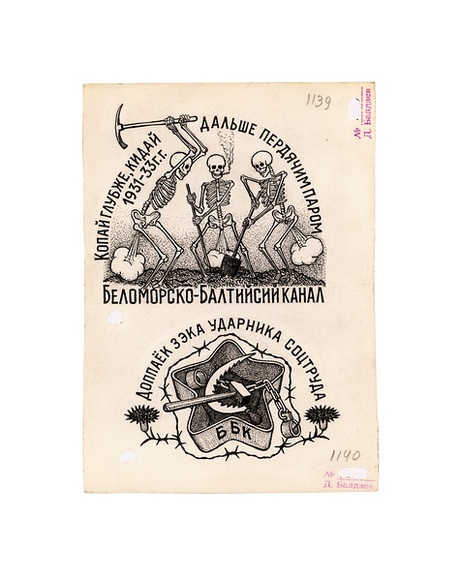
Top: ‘Dig deeper, throw further, farting steam. 1931-33’. Text below reads ‘The White Sea – Baltic Canal’.
Morgue of the Obukhov Hospital, 47 Zagorodny Prospect, Leningrad. 1961.
Left shoulder blade.
Bottom: ‘The extra rations of a convict-hero of socialist labour’. The letters on the cup stand for ‘White Sea – Baltic Canal’.
Hospital No. 32, 4 Lazaretny Lane, Leningrad. 1956.
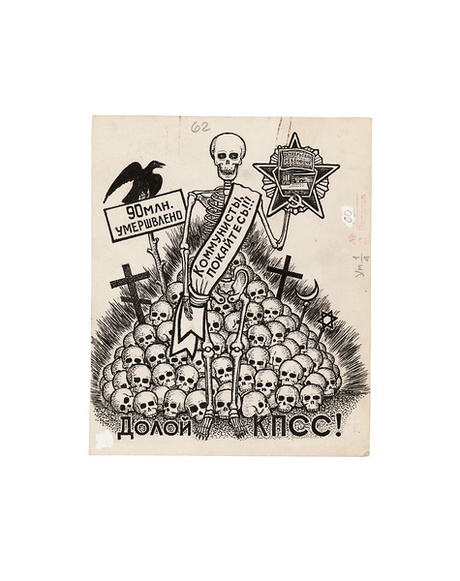
The skeleton holds the Order of the October Revolution. Text on the sign reads ‘90 million were killed’. Text on the skeleton’s sash reads ‘Communists, repent!!!’. Text underneath reads ‘Down with the Communist Party!’.
Dzhidastroy Corrective Labour Camp, Buryat-Mongol ASSR. 1960s.

The views of experts differ on the subject of ‘erotic’ tattoos. Baldaev’s drawings contain images that to the untrained eye appear erotic but have, according to evidence he gathered, been meted out as punishments (for losing at cards etc.). Others maintain that erotic shaming tattoos only ever consist of one subject: a woman entwined with a serpent, which is forcibly tattooed on the back of the victim.
Top left: The tattoo of a passive homosexual.
Top right: ‘Glory to the CPSU!’
Forcibly applied to a prisoner who lost at cards in the strict regime CLC No.9 (1980s). This distinctive ‘grin’, directed at the authorities, always raised a laugh with other convicts.
Bottom centre: ‘The food provision programme of the Communist Party is being fulfiled!’
Bottom right: A tattoo worn by passive homosexuals.

‘Girls, find yourself a generous hand. You’ll be fed, dressed, and entertained, and you’ll pay with your body…’
1 Svechnoy Pereulok ‘The House of Tramps’, St. Petersburg. Lower abdomen.
An artistic tattoo belonging to a young prostitute.
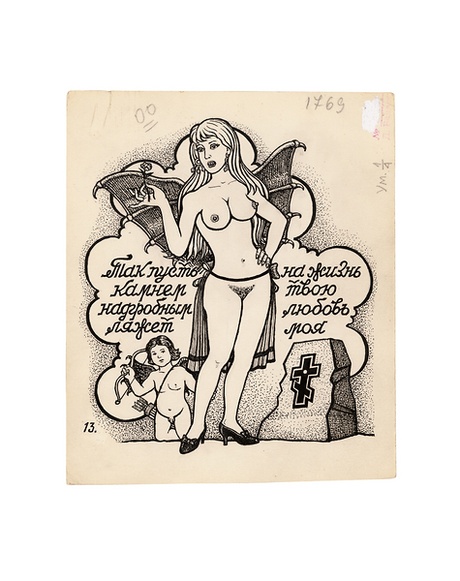
‘So let the gravestone lie on your life, my love’
Corrective Labour Colony No. 5, Leningrad. 1970s. Back.
This very rare artistic tattoo known as ‘The Femme Fatale’ may be located on the back or the stomach.

Left: Detention Centre, Leningrad. 1960s. Hip.
Tattoo popular among both men and women. The men’s interpretation is ‘If I were to sleep with a woman, then it would only be a queen. If I were to steal, then it would be no less than a million’. The women’s interpretation is ‘To live and love life like a queen’.
Right: ‘A house, a dacha and a savings book, a motor boat, a motor car and a garage will satisfy my whim’
Leningrad Pre-Trial Prison. 1960s. Hip.
An artistic tattoo worn by both sexes. On men the tattoo means ‘If I steal, I make it a million. If I sleep with someone, I make her a queen’. The female interpretation is ‘Live and enjoy life like a queen’.
![Lenin shouts ‘Shoot! [them]’. Text on the coffin ‘Communist Party’. Text underneath reads ‘Forward, towards communism!’. Corrective Labour Camp No.5, Metallostroy Settlement, Leningrad. 1980s. Right side of stomach. This tattoo was copied from a prisoner sentenced under Articles 206 and 108 of the Criminal Code of the RSFSR of 1960 for hooliganism and causing severe injuries. The prisoner named Stepan, assaulted a car mechanic who had asked him for a bribe for a new truck. Full of indignation, Stepan said that life was unbearable because of communists. His grandparents were dekulakised. In 1947, his father was arrested for praising Studebaker, Dodge, Chevrolet, Ford, and other American vehicles. His father was shot in a prison camp in Norilsk. His mother was left with three young children, they lived in poverty.](http://www.cvltnation.com/wp-content/uploads/2014/05/Drawing_13_jpg_460x690_q95.jpg)
Lenin shouts ‘Shoot! [them]’. Text on the coffin ‘Communist Party’. Text underneath reads ‘Forward, towards communism!’.
Corrective Labour Camp No.5, Metallostroy Settlement, Leningrad. 1980s. Right side of stomach.
This tattoo was copied from a prisoner sentenced under Articles 206 and 108 of the Criminal Code of the RSFSR of 1960 for hooliganism and causing severe injuries. The prisoner named Stepan, assaulted a car mechanic who had asked him for a bribe for a new truck. Full of indignation, Stepan said that life was unbearable because of communists. His grandparents were dekulakised. In 1947, his father was arrested for praising Studebaker, Dodge, Chevrolet, Ford, and other American vehicles. His father was shot in a prison camp in Norilsk. His mother was left with three young children, they lived in poverty.
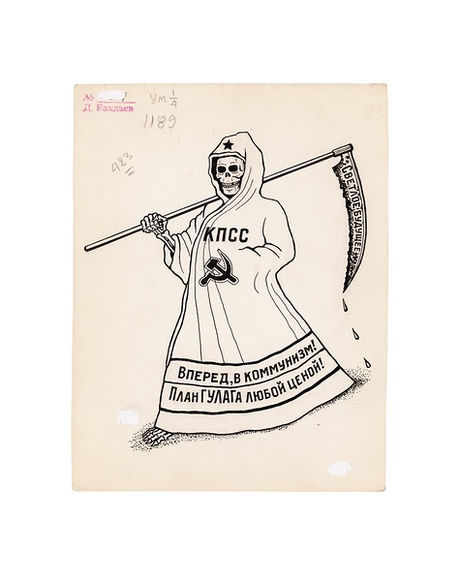
‘CPSU – Forward to communism! The GULAG plan at any price!’ The text on the scythe reads ‘The bright future’.
Morgue, 47 Zagorodny Lane, Leningrad. 1960.
A male convict’s tattoo belonging to a recidivist known as ‘The Professor’.
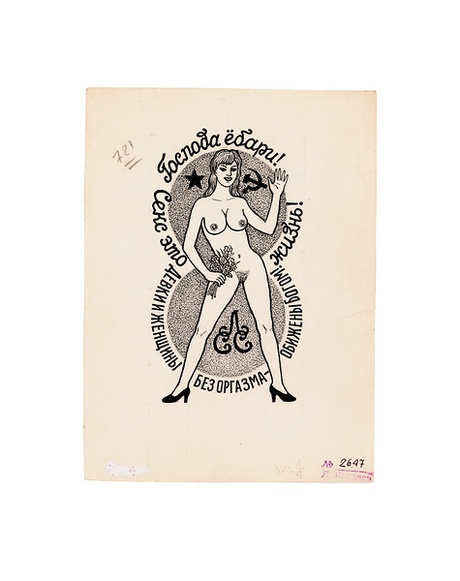
Text at the top reads ‘Gentlemen fuckers, sex is life!’. Text at the bottom reads ‘Girls and women who don’t have orgasms are godforsaken!’.
The monogram ‘LSS’ between her legs stands for Lyublyu SuperSeks: I love super sex.
Specialised Detention Centre of the North-West Transport Department, Ministry of Internal Affairs, Leningrad. 1974. Left shoulder blade.
The tattoo of a woman sentenced for hooliganism under Article 206 of the Criminal Code of the RSFSR. She was detained along with other homeless people in a railroad depot. The tattoo was made in a Corrective Labour Camp for Women in Komi ASSR by an inmate who had formerly been an art student in Moscow.
![Various tattoos depicting skulls. Top row left to right‘Art[icles] 91-10 L [Leningrad]’. ‘Criminal Code of the RSFSR’ ‘1949. Art[icles] 74, 142 of the Criminal Code of the RSFSR’. Middle row left to right ‘Poverty, Hunger, Death. Art[icle] 89. 1961. MGA’. ‘Art[icle] 77, 102 Criminal Code of the RSFSR. 15 [years]’. Bottom row left to right ‘1952. Art[icles] 74, 142 Burmundia – Dzhidastroi 135-146’.‘KPSS–VDSZhVZh’](http://www.cvltnation.com/wp-content/uploads/2014/05/Drawing_16_jpg_460x690_q95.jpg)
Various tattoos depicting skulls.
Top row left to right‘Art[icles] 91-10 L [Leningrad]’.
‘Criminal Code of the RSFSR’
‘1949. Art[icles] 74, 142 of the Criminal Code of the RSFSR’.
Middle row left to right
‘Poverty, Hunger, Death. Art[icle] 89. 1961. MGA’.
‘Art[icle] 77, 102 Criminal Code of the RSFSR. 15 [years]’.
Bottom row left to right
‘1952. Art[icles] 74, 142 Burmundia – Dzhidastroi 135-146’.‘KPSS–VDSZhVZh’
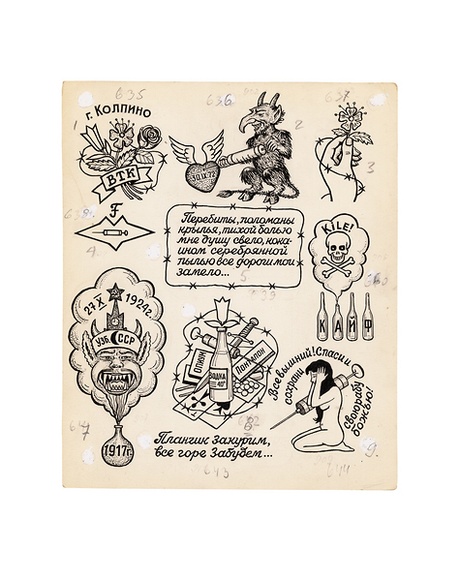
Tattoos signifying addictions.
Top left: ‘Kolpino City. VTK’
Top right: Male or female ‘flower’ youth tattoo.
Middle left: A lesbian addicts tattoo.
Middle centre: ‘My wings are battered and broken, my soul is cramped in silent pain. Drifts of cocaine’s silver powder have covered all my roads…’
Middle right: Text on the bottles reads ‘high’ or ‘buzz’.
Bottom left: ‘27.X.1924’. The date denotes the day the Uzbek Soviet Socialist Republic was founded.
Bottom middle: Text on the label reads ‘Opium, Vodka, Pontalon’.
A male tattoo conveying: ‘This is what is destroying us’.
Underneath: ‘Drugs we will buy, and our grief we will forget!’
Bottom right: ‘All on high! Save your servant, God forbid!’
![From the top the text reads ‘Giant of Soviet thought, C2H5OH [the molecular formula for alcohol]. Down the hatch, Cheering Kremlin Heart Drops, For victory over Chechnya!!!!!’. A caricature known as ‘Japanese eyes’. The wearer fought in the Chechen war of 1994-1996.](http://www.cvltnation.com/wp-content/uploads/2014/05/Drawing_18_jpg_460x690_q95.jpg)
From the top the text reads ‘Giant of Soviet thought, C2H5OH [the molecular formula for alcohol]. Down the hatch, Cheering Kremlin Heart Drops, For victory over Chechnya!!!!!’.
A caricature known as ‘Japanese eyes’. The wearer fought in the Chechen war of 1994-1996.
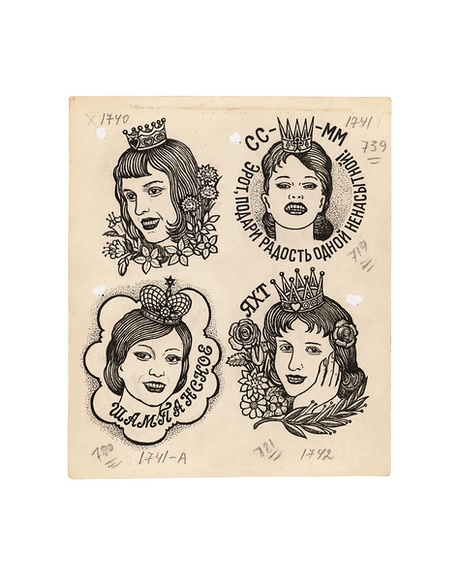
Various tattoos depicting portraits of women.
Top right: Text reads ‘SS–MM’ an acronym meaning Super Seks – Moya Mechta: super sex – my dream; ‘Eros, give joy to an insatiable one!’.
Bottom left: Text reads ‘CHAMPANSKOI’ an acronym whose Russian letters stand for: ‘Is this a joke, or maybe just a hell of a mockery – tell me how to evaluate it?’.
Bottom right: Text reads ‘YACHT’ an acronym meaning ya tebya hachu:
I want you.
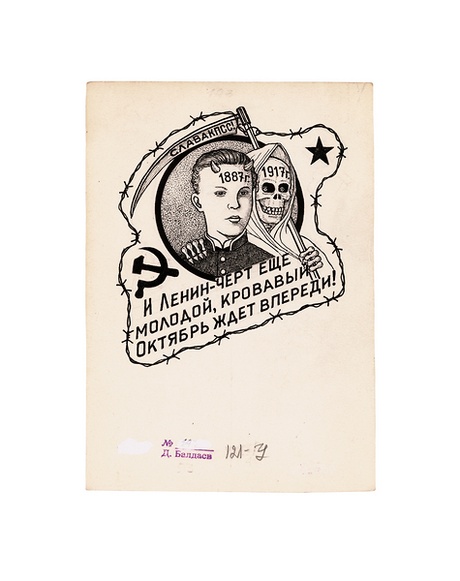
The text on the scythe reads ‘Glory to the Soviet Communist Party!’.
The text at the bottom reads ‘And Lenin is still a young bloody devil. October is still ahead!’ (A parody of a popular Soviet song, the real lyric is: ‘And Lenin is so young and youthful. October is still ahead.’) Dates on the heads ‘1887’ the year of Lenin’s birth.‘1917’ the year of the October Revolution.
Military Unit 48868, 25 Strelbishchenskaya Street, Leningrad. 1976. Hip.
The tattoo of a Dagestani soldier from an engineering battalion.
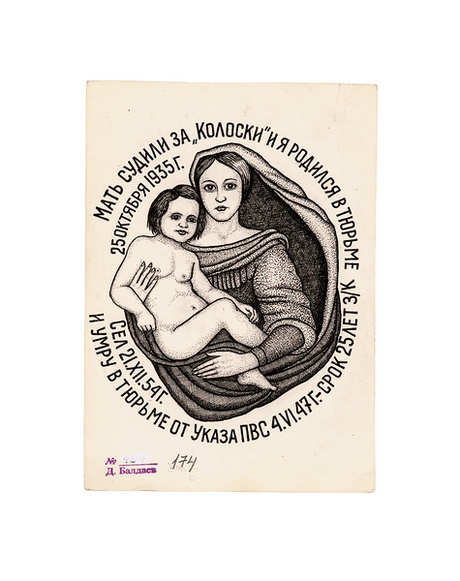
‘My mother was convicted for gleaning grain and I was born in prison on the 25th October 1935. I was jailed on 21.XII.54 and I will die in prison from the Supreme Soviet Presidium decree of 4.VI.47 – a 25-year sentence’
Corrective Labour Colony, Ulan-Ude, Buryat Autonomous Soviet Socialist Republic. 1960s. Chest.
This thieves’ ‘talisman’, based on Raphael’s ‘Madonna from the Sistine Chapel’, was worn by a convict sentenced to twenty-five years for the group theft of food products from a military depot in the town of Irkutsk. He was known as ‘Bely’ (White). According to ‘Bely’, his mother was convicted under a decree of the Council of People’s Commissars from 7th August 1935, for gleaning ears of grain after the harvest had been collected.

Various common women’s tattoos.
Top left: The Georgian text reads ‘Kolhida is a good country, but Russia is best of all’.
Hospital No.4, Kosinov Street, St. Petersburg. 1993. Stomach.
The horseshoe is a symbol of good luck – in this case hope for an early conditional release.
Top right: ‘Kill the non-Russians’.
Middle centre: Pre-Trial Prison No. 2, Leningrad. 1981.
A young woman with two revolvers in her hands signifies a female ‘antisocial’. This youth tattoo means ‘I’m a bandit’ and was widespread in the 1970s
and 1980s.
Bottom centre: ‘My mother-in-law gobbled up my happiness. 1971–1977.’
Detention Centre No.2, Leningrad. 1980s. Right shoulder.
This women’s tattoo is called ‘The Grip of a Cruel Fate’. The bearer, a convict named Katya, was sentenced in the 1970s for severely beating her
mother-in-law.
Bottom right: In memory of parents who died behind bars (either in a prison or gulag). A sentimental tattoo. It stands for: ‘Mother – sleep and wait for me!’
Stomach, hip
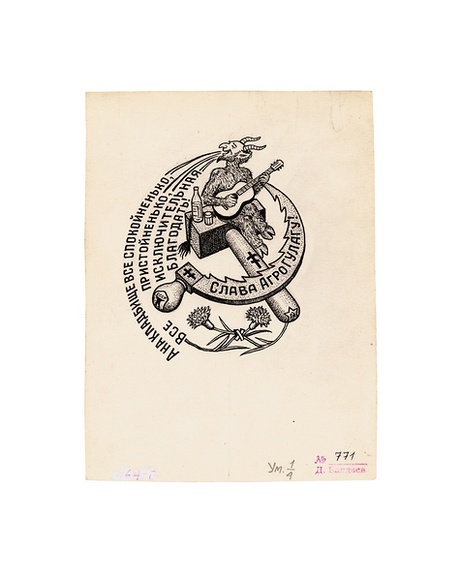
‘But in the graveyard everything is peaceful, everything is proper, absolute bliss!’. Text on the sickle reads ‘Glory to the Agricultural
State Camp Administration!’.
Leningrad. 1989.
![Various tattoos depicting candles. Middle left: This tattoo means ‘I ruined my life with vodka’ (40º is the standard strength of vodka). Middle centre: ‘Taishet and Ust-Kut’ [Gulag towns in the Irkutsk region]. ‘Where will wings of fate take me?’. Middle right: ‘VTK’ Educational Corrective Labour Camp. Bottom left: ‘Fate toys with man’ Hip, stomach, shoulder. This tattoo signifies ‘Dissatisfaction with one’s fate and the anticipation of death’. Common in the late 1940s and early 1950s in the corrective labour colonies of Eastern Siberia. Bottom centre: Latin text reads ‘Life is Brief’. Bottom right: ‘My life – is prison’](http://www.cvltnation.com/wp-content/uploads/2014/05/Drawing_24_jpg_460x690_q95.jpg)
Various tattoos depicting candles.
Middle left: This tattoo means ‘I ruined my life with vodka’ (40º is the standard strength of vodka).
Middle centre: ‘Taishet and Ust-Kut’ [Gulag towns in the Irkutsk region]. ‘Where will wings of fate take me?’.
Middle right: ‘VTK’ Educational Corrective Labour Camp.
Bottom left: ‘Fate toys with man’
Hip, stomach, shoulder.
This tattoo signifies ‘Dissatisfaction with one’s fate and the anticipation of death’. Common in the late 1940s and early 1950s in the corrective labour colonies of Eastern Siberia.
Bottom centre: Latin text reads ‘Life is Brief’.
Bottom right: ‘My life – is prison’
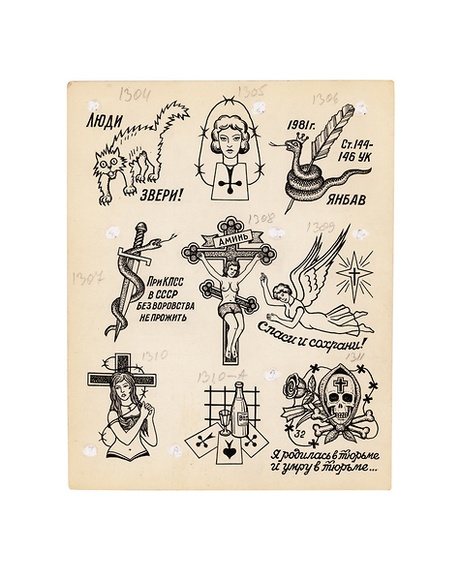
Top left: ‘People are beasts!’
Top centre: 1980s. Hip.
The symbol of female thieves.
Top right: ‘1981. Articles 144-146 of the Criminal Code. YaNBAV’
Middle left: ‘In the USSR you cannot survive under Communist Party without stealing’
Middle centre: ‘Amen’
Middle right: ‘Save and protect!’
Bottom right: ‘I was born in prison and I’ll die in prison…’
The tattoo of a female legitimate thief who had served six sentences (from the number of crosses). She had spent a total of thirty-two years in confinement.
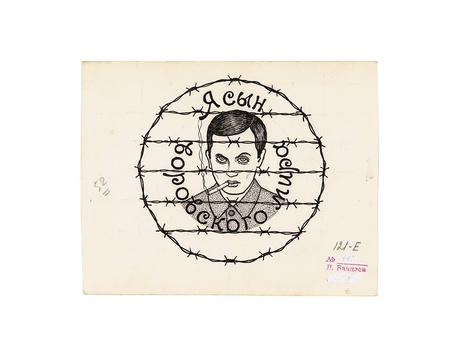
‘I am a son of the world of thieves’
Konyashin Hospital Morgue, 104 Moscow Prospect, Leningrad. 1966.
Right side of chest.
A rare specimen of a tattoo with a portrait. The wearer of this tattoo was killed in an attack on a militiaman (policeman). On 18th July 1966 at about three o’clock in the morning, beside the House of Culture on Moscow Prospect, a ferocious attack was launched on a militiaman on point duty, in an attempt to steal his official issue weapon. The attacker, I. Tikhonov, had several previous convictions for theft. He failed to react to a warning shot from militiaman Stepanov of the Moscow District Militia, and in the ensuing struggle he attacked Stepanov with a knife. He was killed by the second shot from Stepanov’s gun.
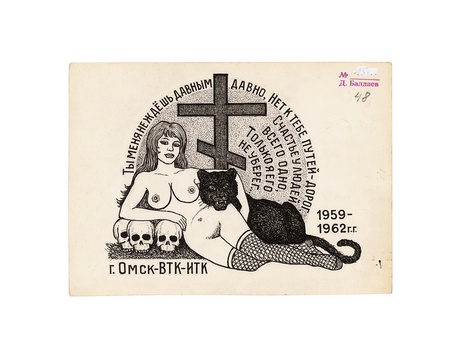
‘You stopped waiting for me a long time ago. There are no roads to
reach you, people have only one happiness, only I did not take care of it… Omsk Educational Labour Colony and Corrective Labour Colony,
1959-1962’
Copied in Isolation Cell Block No.1. 1982. Left side of chest.
A so-called ‘lyrical tattoo’, containing an extract from the words of a criminals’ song. The woman, the black panther and the skulls are symbols of devotion, fearlessness and cruelty. The wearer was twice convicted of theft under article 144 of the Criminal Code of the USSR. The dates 1959-1962 refer to time spent in the Omsk Corrective Labour Colony.
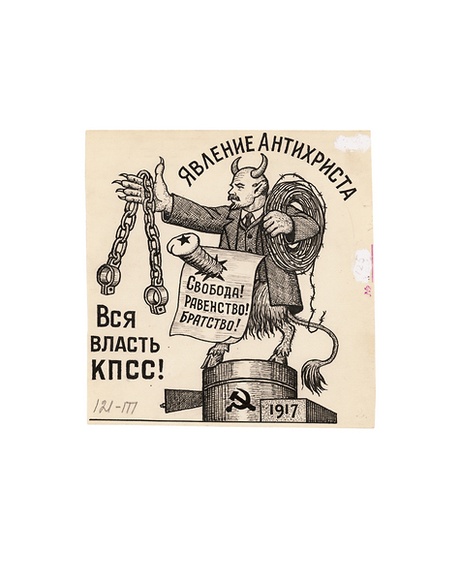
Text at the top reads ‘The phenomenon of the Antichrist’. Text on the top paper reads ‘Freedom! Equality! Brotherhood!’ Text on the left reads ‘All power to the Communist Party!’.
Corrective Labour Colony No.5. 1968. Hip.
Anti-Soviet ‘grin’ at the authorities. The owner of the tattoo was convicted for taking down a propaganda poster in the Babushkin Gardens in Nevsky area, Leningrad. His grandparents had been dispossessed during the collectivization of the Pskov region and sent to Kazakhstan where his mother was born.
![Various criminal tattoos depicting torches – a symbol of freedom. Top left: ‘1947. St. Kitoy’ Corrective Labour Colony No.9. 1981. Shoulder.An old thieves' tattoo of the 1940s and 1950s specifying the place of imprisonment - Kitoy station, near Irkutsk. Top middle: ‘Freedom’ Top right: ‘VTK’ [Educational Corrective Labour Camp.] Middle left: ‘1979-1981. ASP, AIS’. The shackles read ‘BTK, ITK-9’. A prisoner brought up in an Educational Labour Colony (1978-1981, VTK). Aged 18 they were transferred to the adult Correctional Labour Colony (ITK-9). Their initials are either side of the manacles. Bottom right: A thieves tattoo showing the term – seven years.](http://www.cvltnation.com/wp-content/uploads/2014/05/Drawing_29_jpg_460x690_q95.jpg)
Various criminal tattoos depicting torches – a symbol of freedom.
Top left: ‘1947. St. Kitoy’
Corrective Labour Colony No.9. 1981. Shoulder.An old thieves’ tattoo of the 1940s and 1950s specifying the place of imprisonment – Kitoy station, near Irkutsk.
Top middle: ‘Freedom’
Top right: ‘VTK’ [Educational Corrective Labour Camp.]
Middle left: ‘1979-1981. ASP, AIS’. The shackles read ‘BTK, ITK-9’.
A prisoner brought up in an Educational Labour Colony (1978-1981, VTK).
Aged 18 they were transferred to the adult Correctional Labour Colony (ITK-9). Their initials are either side of the manacles.
Bottom right: A thieves tattoo showing the term – seven years.
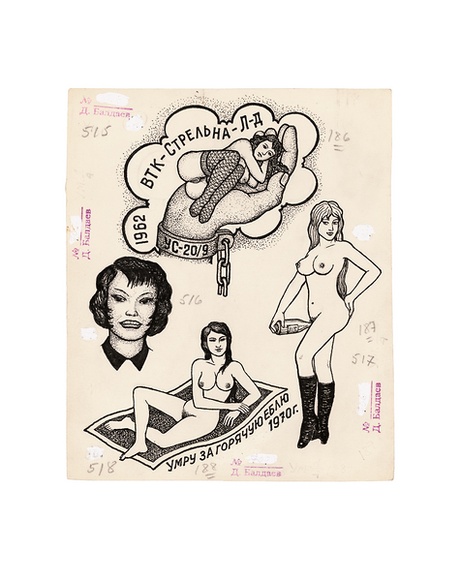
Woman in hand: Text reads ‘1962. Juvenile Corrective Institution, Strelna, Leningrad’. Manacle reads ‘US-20/9’ (the institution’s code).
Corrective Prison Camp No.9. 1970s. Hip.
Men’s youth tattoo. The bearer was transferred to the adult corrective prison camp from a juvenile institution.
Woman on carpet: Text under the carpet reads ‘Dying for a hot fuck. 1970’.
Corrective Prison Camp No.9. 1970s. Hip.
These tattoos, found on various parts of the body, often looked like epaulets. They were popular in male corrective labour camps of Leningrad and the Leningrad Region in the 1960s and 1970s.
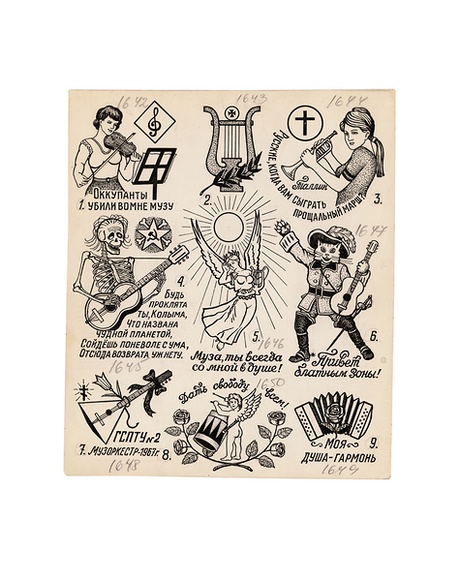
Various tattoos featuring musical instruments.
Woman with violin: ‘Violators killed the muse in me’
Woman with trumpet: ‘Russia, when will you play a farewell march?’
Skeleton with guitar: Poem reads ‘Damn you, Kolyma, though they call you a Wondrous Planet. I’m bound to go crazy here. There’s no coming back from here’.
Angel with harp: ‘Muse, you are always with me in my soul!’
Cat with guitar: ‘Greetings to the criminals of the zone!’
Balalaika: ‘Vocational College No.2 Music orchestra. 1967’
Cupid with drum: ‘Give freedom to everyone!’
Bayan (Russian accordion): ‘In my soul – harmony’

Various cat tattoos. The cat is one of the oldest symbols of criminal world. They are the personification of the thieves’ fortune, prudence, patience, the speed of their actions, their ruthlessness and rage. At the same time they represent the expectations of their victims. The abbreviation KOT (tomcat), which is found in tattoos, is the language of thieves, it means: Korennoy Obitatel Tyurmy (Native prison inhabitant).
Top right: Text reads ‘NVOVDO’.
This is a rare acronym, understandable only to the initiated: NVOVDO – ‘Do not touch the thief, he will always make you surrender!’ 1950s.
Bottom left: The symbols on the hat worn by the cat signify the bearer of the tattoo is otritsaly – a thief who refuses to submit to, and is a malicious infringer of the prison rules.
Bottom right: Text reads ‘All power to the godfathers!’.1980s.
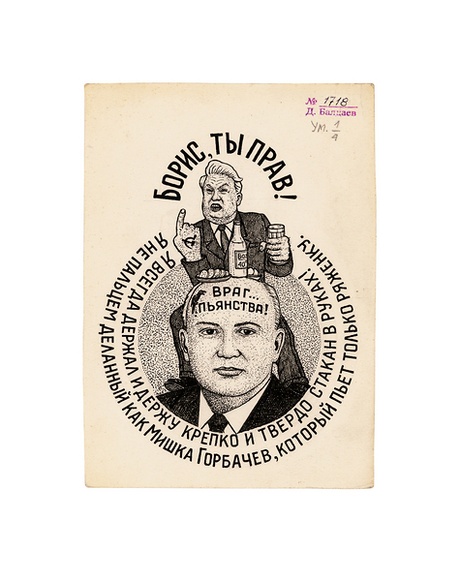
‘Boris, you’re right! I have always grasped and still grasp my glass with firm and steady hands! I’m not a runt like Mishka Gorbachev, who only drinks ryazhenka’ (a yoghurt-like product). Text on Gorbachev’s forehead reads ‘Enemy of drunkenness!’.
A humorous youth tattoo worn by a man who was twice convicted for hooliganism.
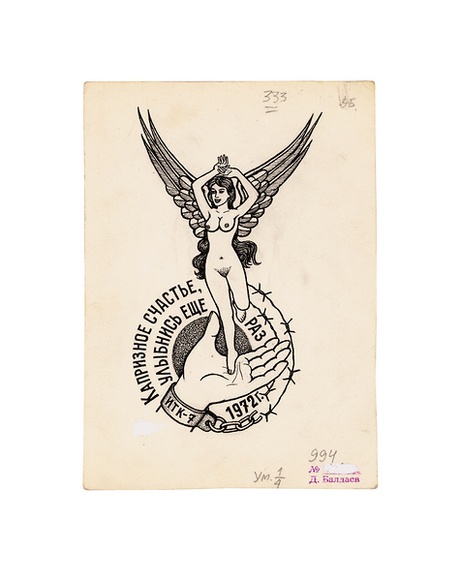
The text reads ‘Oh, fickle fortune, smile on me once more. 1972’. The text on the manacle reads ‘ITK-7’ (Corrective Labour Camp No.7).
Detention Centre for Minor Offenders, 6 Kalyaeva Street, Leningrad. 1981.
This thieves’ tattoo is known as ‘Winged Fickle Fortune’. The wearer dreams of committing a bold, large-scale theft allowing him to give up his life of crime.
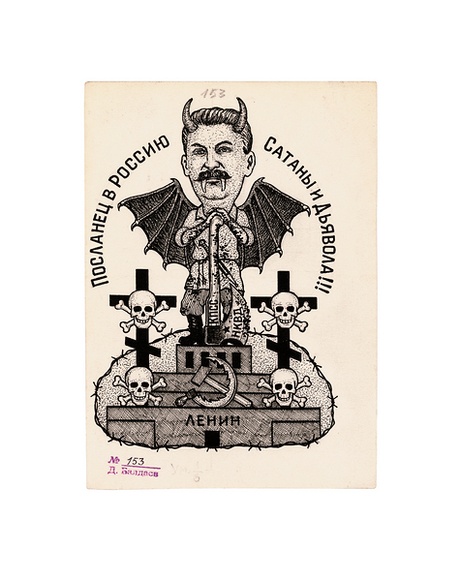
‘Satan and the Devil’s agent in Russia’
Copied from the chest of an authoritative thief nicknamed ‘White’ in 1991. White was descended from the Orenburg Cossacks. He had served a total of thirty-two years in prison for large scale thefts of state and personal property. He fanatically hated the CPSU. White’s parents had been subjected to repression and were shot in 1937. His grandfather fought against the party and was killed in the Civil war. He was put in a children’s home at the age of nine, and after vocational school worked as a turner in a small-arms factory in Izhora. He had served time in Perm, Solikamsk, Sverdlovsk and Vorkuta.
Sick with tuberculosis, he liked to repeat that he didn’t have long to live.
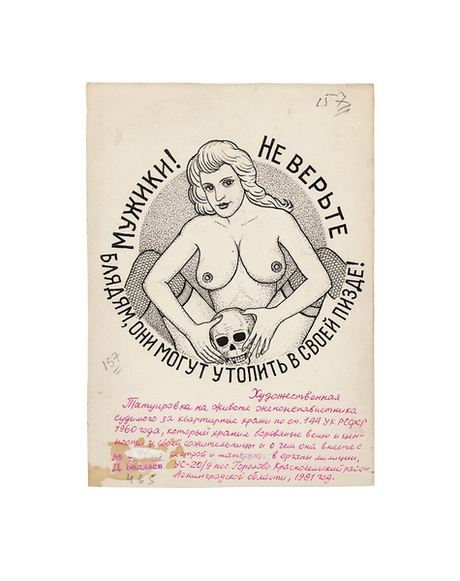
‘Men, don’t trust whores, they can drown you in their cunt!’
Corrective Labour Colony No.9. 1981. Stomach.
Convicted of burglary under article 144 of the 1960 Criminal Code of the RSFSR, this prisoner kept the things he stole at his mistress’s home. She later became afraid of her involvement, and together with her mother and sister betrayed him to the militia.
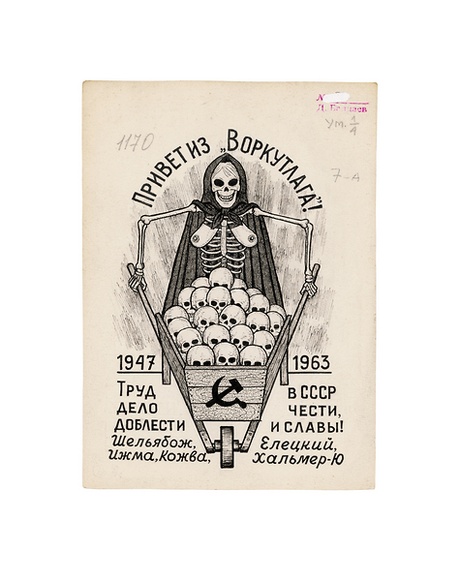
‘Greetings from the Vorkuta Camps! 1947-1963. In the USSR labour is
a matter of honour, prowess and glory! Shelyabozh, Eletsky, Izhma, Kozhma, Khalmer-South’
Ilich Lane Bathhouse, Leningrad. 1964.
A ‘grin’ tattoo worn by a convict from the Vorkuta Camps. The wearer
evidently passed through five corrective labour colonies from 1947 to 1963. The tattoo was made in 1962, a year before he was released.

Top: The acronym stands for ‘Separation is worse than hell, when you’re
not beside me’.
Stomach, hip.
This tattoo means, ‘Husband and wife are a family of thieves’.
Bottom: The acronym stands for ‘Listen, it’s already impossible to stop loving you’.
Stomach, thigh.
A thieves’ family – a husband and the wife. The tulip and the rose symbolise that the 16th and 18th anniversary have been spent in places of imprisonment. The number of barbs on the wire indicates the total term of the sentence
(in this case 8 years).
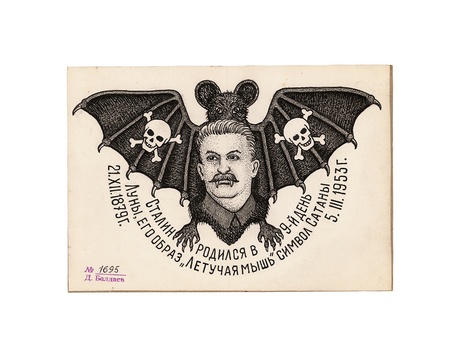
‘Stalin was born in the 9th day of the moon, his ‘bat’ image is the symbol of Satan! 21.XII.1879 – 5.III.1953’ (Stalin’s dates of birth and death).
Kaschenko hospital. 1979. Stomach.
The owner of the tattoo had been convicted for hooliganism twice. He was an alcoholic going by the nicknames ‘Banka-Satan’, ‘Fool’ or ‘Cosack’. After much prevarication, he ‘surrendered’ to the hospital at Kaschenko, to avoid serious complications.

